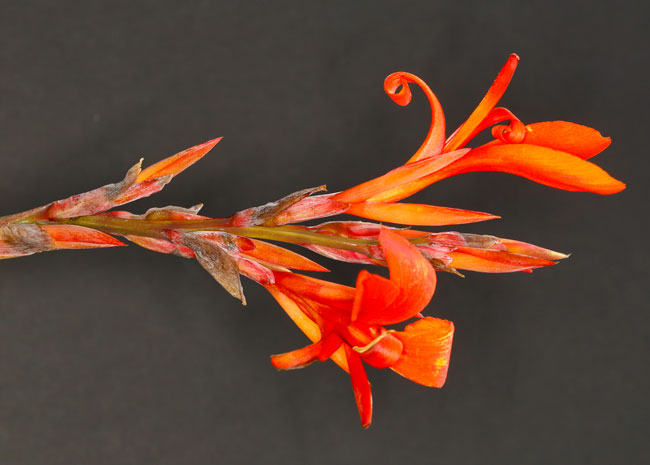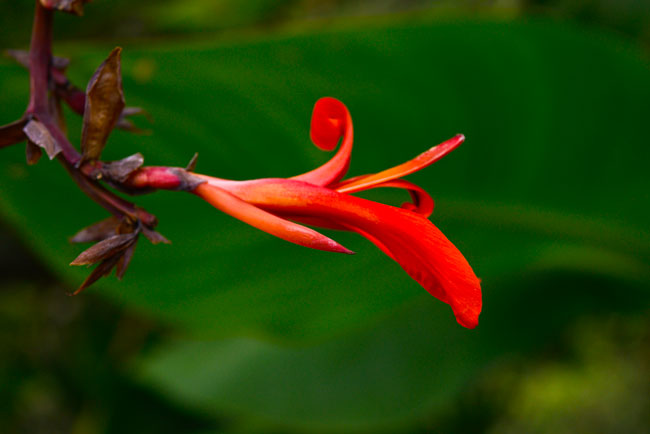Canna indica leaf as tamale wrap
The most common use for this plant is the leaf as a wrap for maize tamales. Canna indica is known throughout Guatemala for this. The leaves are sold at most local Mayan markets, even in larger cities.
I would assume that this leaf is selected over leaves of other plants because of a characteristic which is not yet explained in the literature. My guess is due to flavor, since there are a lot of cheaper alternatives, such as banana leaves. However the leaf of Canna is a much more appropriate size (one leaf to wrap one tamale). With a banana leaf it is huge and has to be cut into segments.
In addition to banana leaves, there are many native Heliconia species widely available in many parts of Guatemala (Heliconia is a relative of the banana and Bird of Paradise, both of which are not native to Guatemala; however banana is probably the single most common plant in Mayan areas, more common than most fruit trees). Ironically Canna is a distant relative of Heliconia and bananas (Wikipedia, Heliconia). Would help to have field work to ascertain whether only banana leaves are used, or whether Heliconia leaves are also used.
This Canna Indica was photographed at the aldea Pachali,Tecpan - Guatemala.
Canna indica is a ornamental species, used widely as a garden plant
Although the leaves are widely used to wrap tamales, the plant is even more widely grown primarily as an ornamental plant. I had it in my garden long before I realized that Canna indica had multiple uses (far more than just wrapping tamales).
Here in FLAAR we have also other type of Heliconia. Its very common to use this plant for decoration because of the his bright colors.
Canna indica is also edible, medicinal:
a plant of many beneficial uses
It is ironic that although Canna indica is native to Mesoamerica, it has more medicinal uses in Africa, Indonesia, and Vietnam than in Guatemala. All these uses raise the logical question of was Canna indica part of Mayan agriculture or kitchen gardens a thousand years ago?
Today Canna indica is mainly used for its leaves to wrap tamales, since there are potatoes and many other root crops to replace the time consuming preparation of the Canna indica rhizome.
And since there are more than 400 medicinal plants in Guatemala (and several thousand in the larger area of Mexico) perhaps the medicinal aspects are not as needed today.
It would definitely be a valid project for a botanist, ethnobotanist, linguist, or agronomist to do field work in all the traditional Mayan speaking areas of Mesoamerica to see what other uses this plant has among the local people.
We asked out Q’eqchi’ gardener and our Kakchiquel and other Q’eqchi’ staff and they all praised the Canna indica leaf for tamale wrap. Indeed one of our staff sells the leaves at the local village market during major holiday seasons (when it is the tradition to eat tamales).
Common names of Canna indica
Canna lily, platanillo, plus words in every local language or dialect. Family Cannaceae.
In Peru the name for Canna is achira.
It is often confusing whether Canna edulis is a synonym for Canna indica, or whether these are separate species. We are using the name Canna indica for the plant in Guatemala.
When does Canna indica flower
We photographed the flowers of Canna indica near Tecpan in July. All the plants were in full flower. I estimate this plant blooms many months out of the year.
Names in Mayan languages for Canna indica
There are 21 Mayan languages in Guatemala alone, and several more in Mexico. Usually a single plant will have up to a dozen different names among all these languages. Here is one sample:
chan k'ala' (Yucatec Maya) (www.cicy.mx).
We are preparing discussions of the three best ways of photographing colorful flowers: with natural sunlight, with flash, or with studio lighting (or with any two of these together).
- How to photograph flowers with sunlight
- How to photograph flowers with flash
- How to photograph flowers with sstudio lightning
The plant
We find this plant wild (between Solola, above Lake Atitlan and the main highway). Plus this plant is in gardens all around the country. We had it in our garden but either it did not reproduce or it got shaded out by the hundreds of other species in our limited research garden space.
The plants above Tecpan were at least 2 meters high. Most photographs do not show the plant this high. This part of Tecpan is pine forests, but in all openings and along all highways you get lots of different species of medicinal plants and colorants. The plants we studied were in a garden area near a house, so we assume these are not wild. But even wild they get rather tall, as we saw in the mountains far above Lake Atitlan, towards the main international highway, along a river (so in a swampy area).
Bibliography on Canna Indica
We are moving forward preparing a bibliography on Canna indica. So far we have found almost nothing for Canna in Guatemala (yes, it is native here; yes it is well known and frequently used for wrapping tamales, but so far no thesis or formal study of uses among the Mayan people).
Most studies on Canna indica are for Asia, Africa, India.
First posted July 15, 2015
as part of our long term research on utilitarian plants of the Mayan speaking people.
















































































